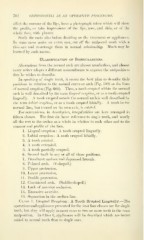Page 714 - My FlipBook
P. 714
712 ORTHODONTIA AS AN OPERATIVE PROCEDURE.
aifect the contour of the lips, have a photograph taken which will show
the ))rofile, or take impressions of the lips, nose, and chin, or of the
whole face, with plaster.
Study the casts also before deciding on the treatment or ai)pliances.
In some cases make an extra cast, cut oH' the mal posed teeth with a
thin saw and re-arrange them in normal relationship. Much may be
learned by such means.
Classification of Irregularities.
Aberrations from the normal arch are almost numberless, and almost
every writer adopts a different nomenclature to express the malpositions
that he wishes to describe.
In speaking of single teeth, it seems the best plan to describe their
positions in relation to the normal curve or arch (Fig. -599) or the lines
of normal eruption (Fig. 600). Thus, a tooth erupted within the normal
arch is well described by the term Ungual ervption, or as a tooth erupted
lingually. A tooth erupted outside the normal arch is well described by
the term labial eruption, or as a tooth erupted labially. A tooth in the
normal line, but turned on its own axis, is rotated.
For convenience in description, irregularities are here arranged in
fifteen classes. The first six have reference to single teeth, and nearly
all the rest to the arches as a whole in relation to each other and to the
contour and profile of the face.
1. Lingual eruption A tooth erupted lingually.
:
2. Labial eruption A tooth erupted labially.
:
3. A tooth rotated.
4. A tooth extruded.
5. A tooth partially erupted.
6. Several teeth in any or all of these positions.
7. Prominent canines and depressed laterals.
8. Pointed arch. (V-shaped.)
9. Upper protrusion.
10. LoAver protrusion.
11. Double protrusion.
12. Constricted arch. (Saddle-shaped.)
13. Lack of anterior occlusion.
14. Excessive overbite.
15. Separation in the median line.
Class 1. Ling-ual Eruption A Tooth Erupted Lingually.—The
:
operations and appliances presented for the first four classes are for single
teeth, but they "will apply in most cases to two or more teeth in the same
malposition. In Class 6, appliances will be described which are better
suited to several teeth than to single ones.


